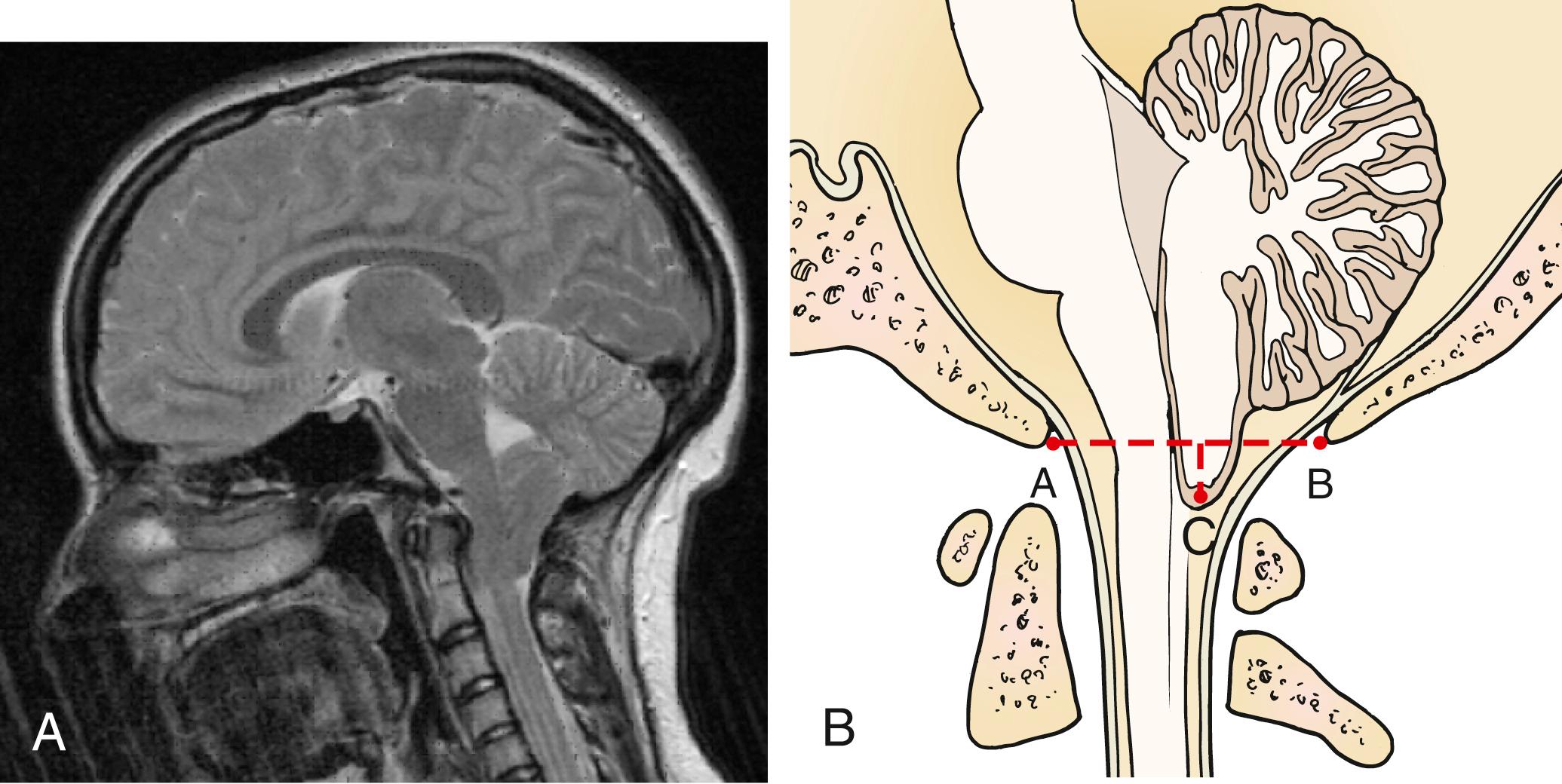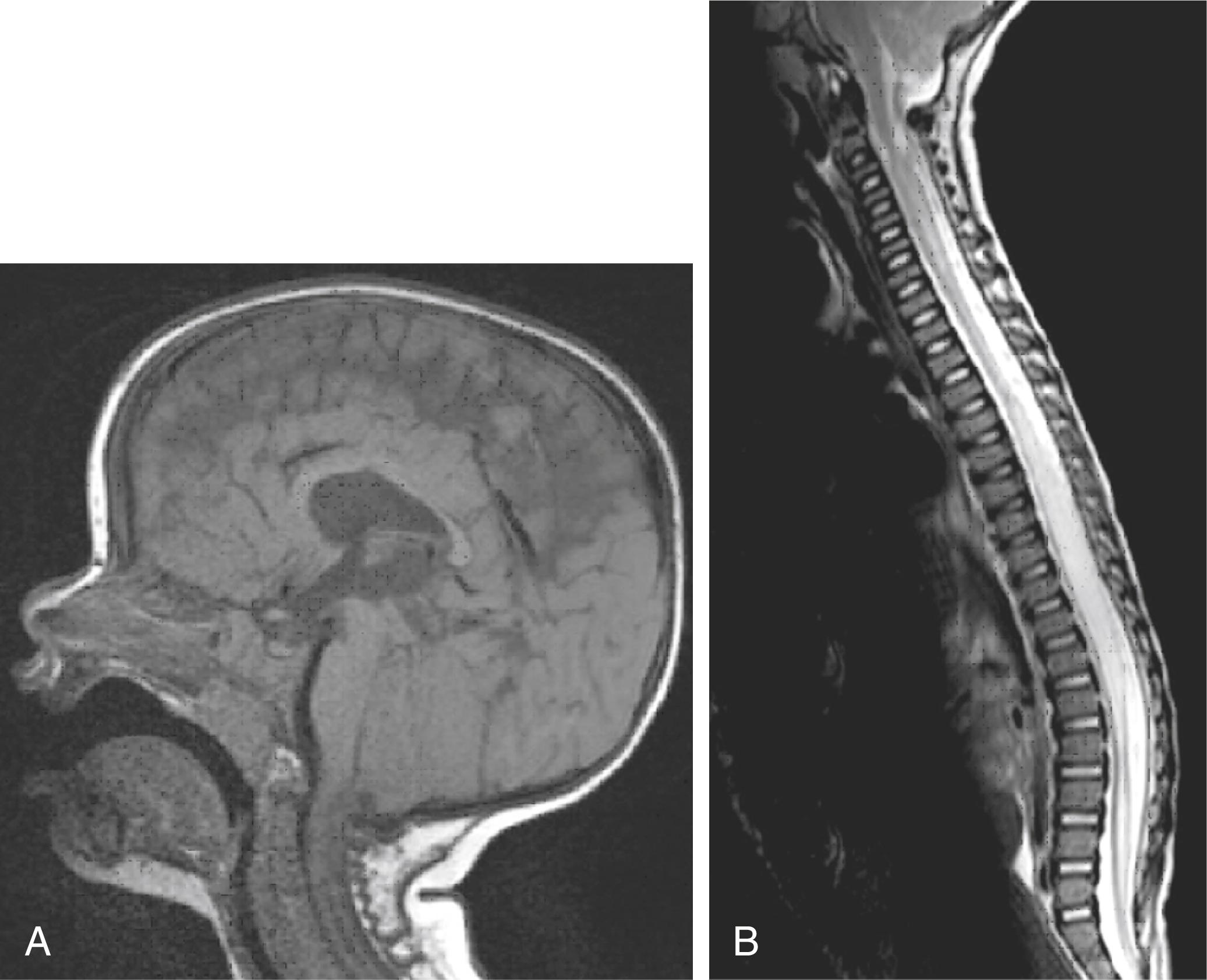Physical Address
304 North Cardinal St.
Dorchester Center, MA 02124
The Chiari malformations are a spectrum of developmental conditions involving bone and parenchymal abnormalities of the hindbrain and craniovertebral junction.
The Chiari I malformation is defined by the anatomic anomaly of cerebellar tonsil descent below the foramen magnum, causing at least one of these physiological consequences: traction or compression of adjacent neural structures and aberration of cerebrospinal fluid (CSF) flow in the cranial or spinal compartment.
Chiari II malformations are associated with myelomeningocele, and Chiari III malformations are associated with meningoencephaloceles. In our regional pediatric series of Chiari I malformations, a significant proportion of patients had associated syringomyelia and scoliosis.
Presentation is variable and depends on the type of malformation. Common symptoms in Chiari I malformation include occipital or cervical pain induced with Valsalva or “tussive” maneuvers, and neurological deficits may include dysesthetic pain, numbness, or weakness related to syringomyelia, or cranial nerve paresis from brain stem compression.
Surgical management of Chiari I malformation is accomplished via posterior fossa decompression and CSF flow restoration. In addition to symptomatic presentation, the presence of syringomyelia or the progression of scoliosis may be indications for surgical management.
Expected outcomes in appropriately selected patients undergoing decompression for Chiari I are quite good, with an excellent safety profile. The utility and safety of duraplasty as part of decompressive surgery remains an area of ongoing study.
The Chiari malformations are commonly encountered in both pediatric and adult neurosurgical practices. Multiple variations in the anatomy of the rhombencephalon have been described, leading to the familiar numeric Chiari designations. However, the various conditions that bear the name of Hans Chiari do not represent a unified spectrum of disease.
John Cleland (1835–1925) was among the first to describe hindbrain herniation in a patient with myelodysplasia. In 1883, Cleland published “Contribution to the study of spina bifida, encephalocele and anencephalus,” which included an illustration and a description of patients with hindbrain herniation, in the Journal of Anatomy and Physiology . Julius Arnold (1835–1915) also discussed a patient with hindbrain herniation and myelodysplasia in 1894. , In 1891 and 1896, Hans Chiari (1851–1916) provided descriptions of hindbrain herniation in postmortem specimens in which variations I through IV were described, , work that led to his name being associated with the condition.
The surgical treatment of Chiari malformations began with the technique described in 1938 by Penfield and Coburn, in which they presented a patient who underwent posterior fossa decompression and subsequently died. Early experience with this procedure was marked by a high rate of operative complications and death. Gardner and associates noted five deaths among 74 patients undergoing posterior fossa decompression. Williams reported five deaths in 41 cases and also described increased neurological deficits, increased ventricular size, and arachnoiditis in his patients. Despite these inauspicious beginnings, modern surgical techniques have made Chiari surgery extremely safe.
The anatomic pathology in the Chiari I malformation causes several resultant physiological consequences. First, Chiari I malformation is marked anatomically by caudal descent of the cerebellar tonsils, causing crowding at the level of the foramen magnum, and frequently deformation of the cerebellar tonsils such that they are “pegged” in shape. Volumetric analysis has demonstrated reduced posterior fossa volumes, increased cerebrospinal fluid (CSF) volumes, and normal brain volume in cohorts of patients with Chiari malformation. Cerebellar tonsil descent of 5 or more mm on magnetic resonance imaging (MRI) is the most commonly used radiographic screening criterion for Chiari I. However, this tonsillar descent is not the sole pathological finding in Chiari I malformation. The condition is also defined secondarily by the physiological impact of this tonsillar descent. Specifically, there is obstruction of normal CSF flow through the craniovertebral junction (CVJ), as well as traction or direct compression upon neural structures, at the level of the foramen magnum. CSF flow aberrations through the CVJ are hypothesized to be a pathological result of the anatomical tonsillar descent. Obstruction of normal CSF flow affects the cranial and spinal CSF compartment, which contributes to the progression of syringomyelia.
Resultant symptoms typically arise from the spectrum of physiological pathologies, and can be categorized as symptoms related to neural traction or compression, symptoms related to CSF obstruction affecting the cranial compartment, or symptoms related to CSF obstruction affecting the spinal compartment.
Patients frequently present with nondermatomal “tussive” pain in the occipital or cervical region that is exacerbated by the Valsalva maneuver, believed to be a manifestation of elevated CSF pressure, venous engorgement, and dural distension in the intracranial compartment. ,
Symptoms derived from direct neural traction or compression, such as sleep apnea, cerebellar dysfunction, and lower cranial nerve deficits, are less common. Neurological symptoms described in association with Chiari I malformation include numbness, weakness, clumsiness, dysphagia, dysarthria, ataxia, and incontinence ( Box 28.1 ). Signs on examination can include nystagmus, altered peripheral reflexes, cerebellar signs, and lower cranial nerve dysfunction including dysarthria, palatal weakness, and decreased gag reflex.
A spinal cord syrinx is the most common manifestation of CSF flow obstruction in the spinal compartment, occurring in a significant proportion of pediatric patients in selected studies. Syrinx formation more frequently involves the cervical and upper thoracic cord, although all segments of the spinal cord may be involved. Thus, the suspended, dissociated sensory dysfunction that typifies syringomyelia often involves the upper extremities, creating the classic “cape-like” distribution of symptoms. Scoliosis can also be seen in association with an underlying spinal cord syrinx, , and is frequently the reason that otherwise asymptomatic Chiari I malformations are identified in children.
Chiari I is infrequently associated with hydrocephalus ( Table 28.1 ), as well as with a number of other conditions ( Box 28.2 ) seen on imaging and at autopsy in patients with Chiari I malformations ( Fig. 28.1 ). Abnormalities of the skull base and CVJ, including a small posterior fossa, empty sella, platybasia, basilar impression, Klippel–Feil abnormalities, and atlantoaxial assimilation are known to be associated. MRI is used to demonstrate cerebellar tonsils below the level of the foramen magnum, and may show decreased flow posteriorly at the CVJ. , Imaging also may demonstrate levoconvex scoliosis, in contrast to the dextroconvex curve usually seen in idiopathic scoliosis.
| Type | Description |
|---|---|
| Chiari I | >5-mm tonsillar herniation below the McRae line, obstruction of CSF flow at CVJ |
| Syringomyelia and scoliosis possible | |
| Chiari II | Herniation of brain stem, cerebellar vermis, fourth ventricle through foramen magnum |
| Associated with myelomeningocele | |
| Hydrocephalus common | |
| Syringomyelia common | |
| Chiari III | Foramen magnum/high cervical encephalocele |
| Chiari IV | Cerebellar hypoplasia or aplasia |
| Chiari 1.5 | Low brain stem and fourth ventricle |
| Caudal displacement of cerebellar tonsils | |
| No associated myelomeningocele | |
| Chiari 0 | Crowded posterior fossa without hindbrain herniation; obstruction of CSF flow at CVJ |
| Syringomyelia |
Klippel–Feil syndrome
Type 1 neurofibromatosis
Apert syndrome
Crouzon syndrome
Metopic and multisuture synostosis
Odontoid retroflexion
Pierre–Robin syndrome
Caudal regression syndrome
Costello syndrome
Paget disease
Craniometaphyseal dysplasia
Growth hormone deficiency
Cloacal exstrophy
Hemihypertrophy
Rickets
Acromegaly
Lipomyelomeningocele

The role of skull base and CVJ abnormalities in the development of Chiari I malformation and cranial settling has been increasingly recognized. The degree of bone compression of the foramen magnum can be evaluated by assessing the clival-basal angle (CXA), with significant kyphosis characterized by an angle less than 150 degrees. To objectively understand what amount of encroachment from ventral compression by the odontoid process into the cervical canal is tolerated, a line can be drawn between the basion and the posterior inferior aspect of C2 (pB‒C2). This line, described by Grabb and colleagues, is used to measure the distance from that line to the ventral cervical canal. Patients with more than 9 mm of encroachment by the odontoid at that point may benefit from an occipitocervical fusion before or during a cervical decompression for their Chiari I malformation. Other abnormalities, such as basilar invagination and clival hypoplasia, may be seen with Chiari I malformation. Interestingly, increased bony compression was negatively correlated with syrinx formation. Assessment of bony ventral canal narrowing demonstrated higher rates of symptomatic relief and syrinx resolution in patients with greater than 3 mm of encroachment.
Bollo and coworkers demonstrated that underlying atlantooccipital instability contributes to the pathophysiology and symptom progression of Chiari malformation, with CXA less than 125 degrees, Chiari 1.5 (defined later), and basilar invagination suggesting that patients may benefit from occipitocervical fusion as an adjunct to standard posterior fossa decompression.
We meticulously analyze radiological studies for frank instability, CXA, pB-C2, and Wackenheim line in each patient before proceeding with a posterior fossa and C1 decompression. Measurements suggesting pathological conditions, coupled with associated signs and symptoms, can change surgical management.
Chiari II malformation is characterized by caudal herniation of the cerebellar vermis, the brain stem, and the fourth ventricle in the setting of myelomeningocele. Hydrocephalus, along with multiple skeletal and intracranial abnormalities ( Box 28.3 ), is common in patients with this condition. After closure of the myelomeningocele and treatment of any associated hydrocephalus, patients may display symptoms of irritability or apnea as the first sign of a Chiari II malformation. Aspiration can lead to recurrent pneumonia, and problems with dysphagia and dysarthria may be evident. Hindbrain anomalies and the attendant risk of respiratory insufficiency are the leading cause of death in myelodysplastic patients. Findings on physical examination include downbeating nystagmus, quadriparesis with hypotonia, ataxia, ocular motility defects, diminished gag reflex, and stridor (see Box 28.1 ). Symptom onset in older children usually indicates spinal cord tethering, shunt malfunction, or the development of syringomyelia.
Craniolacunia
Small posterior fossa
Frontal bone scalloping
Petrous bone scalloping
Clival concavity
Low-lying inion
Large occipital keel
Atlas assimilation
Klippel–Feil deformity
Basilar invagination
Hydrocephalus
Colpocephaly
Asymmetry of the lateral ventricles
Vertical straight sinus
Low-lying torcula
Complete or partial agenesis of corpus callosum
Polygyria
Cortical interdigitation
Enlarged massa intermedia
Tectal beaking
Split cord malformation
Syringomyelia
Imaging and autopsy findings in patients with Chiari II malformations include complete or partial agenesis of the corpus callosum and septum pellucidum, prominence of the anterior commissure, polygyria, interdigitation of the occipital and parietal lobes, partial or complete agenesis of the olfactory bulb/tracts, enlargement of the massa intermedia, or fusion of the colliculi (i.e., tectal beaking). In addition, the cranial nerve nuclei can be malformed. The cerebellum is reduced in size, there can be dysplasia with absent folia, the medulla can be elongated and flattened with the classic medullary kink, and the cranial and upper cervical nerves can course upward. Bony abnormalities of the skull can include scalloping of the petrous bone and lückenschädel, which is a beaten copper or fenestrated appearance of the calvaria on imaging. In these patients, the posterior fossa is small, and basilar impression/assimilation can be seen. Spine anomalies can include Klippel–Feil deformities and enlargement of the cervical canal. Hydrocephalus is seen in upward of 90% of patients with Chiari II malformation, and the ventricles may demonstrate colpocephaly. The tentorium usually is low-lying, creating a more vertical straight sinus and low-lying torcula. In addition to the myelodysplasia, associated spinal cord abnormalities include split cord malformations and syrinx formation ( Fig. 28.2 ). ,

Regarding Chiari II, McLone and colleagues posited the unified theory that CSF loss at the myelomeningocele site reduces the volume of CSF needed to distend the developing ventricular system, leading to caudal displacement of hindbrain structures. Research continues in an effort to understand the exact pathophysiological processes that lead to these malformations and associated symptoms.
Become a Clinical Tree membership for Full access and enjoy Unlimited articles
If you are a member. Log in here